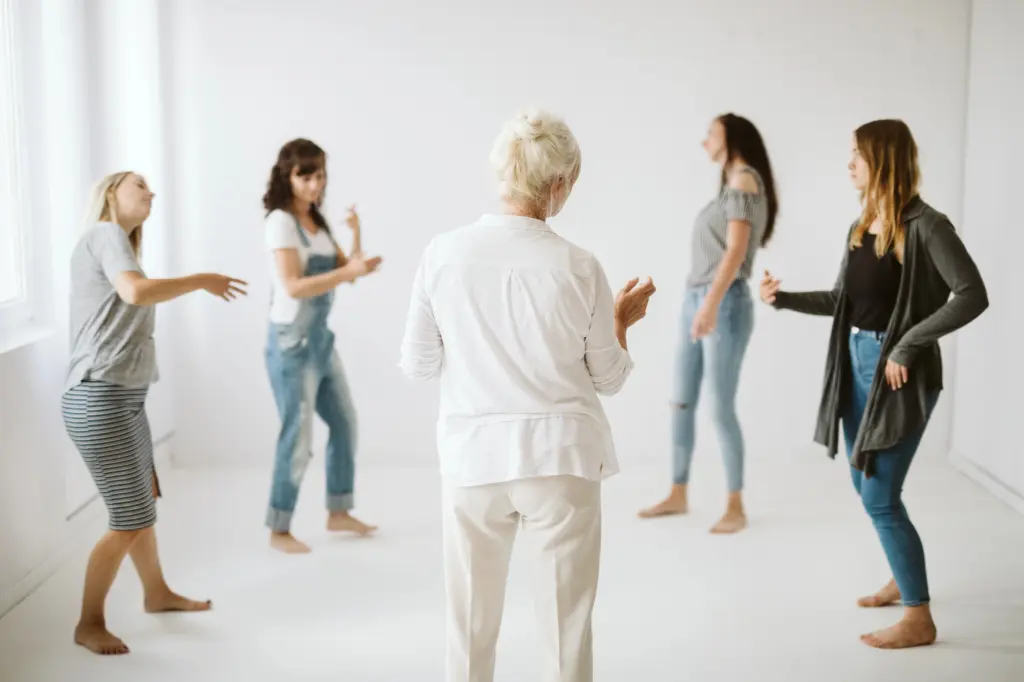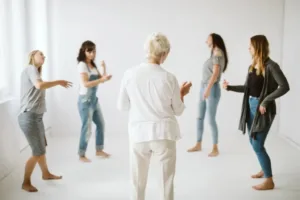What are somatic exercises?
Somatic exercises are a new online fad. You can see short videos or ads for exercises that show people crying or screaming in anger. If you want to safely explore how emotions show up in your body, you’d be better off taking a live somatic exercise workshop. Taking your first steps under the guidance of an experienced somatic therapist or facilitator is key, as your mental well-being is at stake.
Let’s dig deeper into what somatic practice really is and how it can help you regulate your emotions, support your psychological healing, and build psychological resilience.

Somatic exercises: A Body-Mind Practice
Somatic means linked to the body. You may say, “Wait a minute, aren’t all exercises linked to the body?” Absolutely! But there are different reasons to move your body.
If you do fitness exercises, you want to lose weight, build muscle, or stay in good health. The focus here is on the physical function. Yes, you may feel mentally better after a great gym or pulse-racing cardio session, but your mental well-being is more of a side effect than the primary goal.
If you do yoga, especially its more classic forms, you’ll focus not only on doing the poses but also on your breathing and thoughts. Traditional yoga is a spiritual practice that can provide deep insights and help you stay resilient.
Somatic exercises are, in essence, a therapeutic practice. There are many different schools of somatic practice, and the one I facilitate is called bioenergetic exercise. Alexander Lowen and his students have developed these exercises since the 1950s. The idea behind them is to help you understand how emotions feel in your body. By increasing your somatic awareness, you can begin to regulate your feelings. What for? To take care of your mental health, improve your mood, and increase your psychological resilience.
By increasing your somatic awareness, you can begin to regulate your feelings.
Sprawdź nadchodzące warsztaty lowenowskie
Are Somatic Exercises for Me?
If you ask me whether somatic exercise workshops are a good option for you, I say, try them out and see how you feel. People who join my bioenergetic exercise workshops fall roughly into two categories:
- Self-development seekers. These people don’t have any significant mental health concerns. They are looking for ways to get to know themselves better. I’ve had participants complain about work overwhelm, trouble sleeping, and difficulty saying no to people. They may have tried yoga, mindfulness, or intuitive dance, and are curious to try something new.
- Talk therapy clients. These people are currently in talk psychotherapy, or have done it in the past, but feel like their emotional issues require an additional, body-oriented approach. Typical examples are participants with psychosomatic concerns, such as unexplained headaches or stomach pains. Some have body image issues, others are trying to heal from trauma.
You don’t need to worry about your age, gender, or fitness level. Just make sure the workshop you’re interested in is open to all, or is explicitly designed for a particular group, like people who identify as men or older people, etc. The majority of providers work with adults only, but some specialize in teenagers. In that case, parental consent may be required.
When Not to Attend a Somatic Exercise Workshop?
Bioenergetic exercises are great, but a group setting is not always the best. Sometimes we recommend individual sessions to ensure you feel safe and receive tailored guidance that meets your needs. If you have doubts, listen to your intuition and double-check with a healthcare provider.
General contraindications to keep in mind are:
- You don’t feel mentally stable. This is a very subjective matter, and it’s best to discuss it with your psychiatrist or therapist first. If you’ve gone through a recent traumatic experience, it might be better to wait a bit. Anyone going through an acute phase of a mental health condition, such as depression, frequent panic attacks, or a manic episode, should first aim to regain stability with medication and/or therapy.
- You have a history of psychotic episodes. Since bioenergetic workshops can evoke strong feelings and emotional states, they are generally not recommended for people treated for psychotic symptoms.
- You’re pregnant or postpartum. This is a general precaution as we cannot predict how you’ll react during these workshops. One exercise may be super easy for one person, and another may respond with anxiety or overstimulation. It’s not to say that you can’t do any of these practices in pregnancy – for example, increasing self-awareness can prove helpful in that intense period of your life. I would, however, recommend working with a somatic psychotherapist one-on-one in this case.
- You’re very sensitive to and triggered by loud noises and expressive movement. If you hate it when someone raises their voice in your presence, stomps, or waves their hands, then a group workshop of somatic exercises is a no-no. Part of the somatic practice is emotional expression, and for some people, this means being loud and highly energetic in their movement. Again, it’s possible to do some bioenergetic work in such a case, but individual sessions with a somatic therapist are a safer alternative.
- You have a serious health condition and/or take strong medication. This one is a case-by-case scenario. You should consult your healthcare provider first to ensure that the exercises are safe for you. In workshops, we often get the pulse racing and mobilize certain body parts or organs for intensive work (for example, when we learn to breathe deeply). Disability in itself is not a contraindication, but there may be practical obstacles to discuss (such as barrier-free access to the room or the need for a personal assistant throughout the workshop).

What Happens During Somatic Practice?
Before I explain what a somatic exercise workshop looks like, let me give you some reassurance. The main rule of this practice is that you only do what you feel comfortable doing. If you become overwhelmed or need a break, you’re free to stop at any time and get some rest. There’s no pressure, only freedom.
Sometimes people have concerns about bioenergetic exercises, thinking they are purely cathartic. They worry they will have to scream, shout, and throw themselves on the floor. While intense, expressive exercises are a part of Alexander Lowen’s somatic therapy method, not all workshops include this type of work. And even if they do, you decide how you want to make use of it.
When you join one of my basic workshops, here’s what you can expect:
- Ground rules. When a group of strangers meets to do a body/mind practice, they should decide together on the principles. Knowing what’s acceptable and what isn’t creates a sense of trust and safety.
- Some theory. Each workshop has a theme, for example, an introduction to somatic exercises or working with anger. As your facilitator, I will share some basic concepts from the theory of bioenergetic therapy, and we will have a group exchange to deepen our understanding of what we’re about to experience.
- Somatic practice. We will work in blocks of approximately. 20 minutes. First, we do the exercises. In some workshops, I also suggest pair interactions, but it’s up to you to decide whether you want to participate. After each exercise, we don’t rush to the next one. We take at least a minute or two to feel the effect of somatic work in our bodies and emotions. At the end of the sequence, anyone who wants to can share their insights and ask questions.
- Closing circle. At the end of the workshop, I will invite you to talk about your takeaways and which exercises you want to take with you and do more regularly in your everyday life.
Examples of Somatic Exercises
OK, it all sounds fun, but you’re still curious what kind of exercises we’ll be doing? Here are some examples, from more gentle to more advanced:
- Grounding exercises. They help you feel the stability necessary to access your emotions. Many of these practices include activating your feet to increase contact with the floor.
- Tension exercises. You will try positions that are not comfortable, for example, arching your back. The goal of these is not to build stamina but to push you to breathe deeper, make sounds, and get in touch with your feelings. You may notice your irritation growing, or you may find pleasure in the exertion.
- Comparing sides. When we work with one part of the body, we take a break afterward to compare how the sides of our body feel. You usually notice that somatic work on one side makes you feel more relaxed and in tune with your body and mind. This helps you in daily life—you get better at recognizing signs of stress or anxiety.
- Expressive exercises. These can include energetic movements, such as stomping or kicking. Sometimes we add sound or words, such as “stop”, “no”, or even whole sentences such as “get off my back.” If you’re not ready to get verbally expressive, you can begin by thinking those words while doing the movements.
- Self-soothing exercises. Some of the somatic practices include (non-erotic) self-touch. For example, you massage your feet or hold your head to give yourself a sense of comfort and security.
- Interactions with others. Group practice is so powerful because you get to train in expressing your authentic emotions in the presence of others. Isn’t it just like in real life? It’s different to say “give it to me” when facing a wall, and when standing in front of a human being who sees you making that demand. This kind of work is not easy at first, but it’s deeply transformative.
What You Gain From Somatic Practice
When Alexander Lowen developed his body psychotherapy method, he spoke about the sense of being alive. He believed that a truly healthy person is joyful and confident. They happily connect with other people, form strong relationships, and feel sexual pleasure. As a testament to his approach, Lowen regularly did his own exercises and lived until 97!
The effects of body psychotherapy, both individual and in groups, have been studied for decades. Here are some of the discoveries about group somatic work:
- In a 2006 randomized controlled study, a group of patients with chronic psychosomatic symptoms participated in one-hour bioenergetic exercise workshops twice a week for 6 weeks in addition to their regular medication and therapies. Those people improved their somatization symptoms (meaning the physical signs of psychological problems), had lower depressiveness and anxiety, and lowered their anger levels.
- A 2013 clinical trial conducted with patients with depressive disorders revealed that group body psychotherapy helped those people become more aware of how their bodies respond to emotions and depressive states. The exercises helped participants unblock repressed emotions (such as anger), see themselves in a more positive light, and improve their social interactions. Participants attended 20 sessions over 18 months.
- According to a 2023 review of evidence on the use of Bioenergetic Analysis and Therapy, bioenergetic exercises in groups had, among other effects, a positive effect on emotional regulation, social control, psychological well-being, body awareness, and pain.
Speaking from my own experience as someone who has been doing somatic exercises for many years, and from the experience of my clients, I can add that this practice is a valuable tool to manage your emotions in everyday life.
When you feel down, you can use these exercises to boost your energy levels and get back on your feet. When you’re worried and can’t sleep, you can ground yourself and regulate your nervous system. As a mom, I often lock myself in the bedroom for a few minutes to kick and hit the mattress – this way I can safely let go of the frustration or tension that inevitably comes with being a parent without placing an extra burden on my child.
Benefits of Doing Somatic Work in a Group
I still remember one of the first bioenergetic exercise workshops I facilitated. It was about anger. We talked about the difference between destructive and healthy anger, which in itself was a big a-ha moment for some participants.
As the workshop progressed, I decided to take a risk and suggest one exercise in pairs. I guided the group to take turns saying “no” out loud and also making a gesture to strengthen that message. The result was astounding. Participants shared how difficult it was for them to say no and how uncomfortable it felt to hear a “no” from somebody else, especially when said in an angry tone.
During the closing session, most people said they had realized how much work they still had to do in expressing their frustrations and setting boundaries. It struck them how big a taboo there is around anger and rage (especially for women).
That’s the power of group work. You can challenge yourself to feel and show your emotions with other people in the room. You may decide to go into a deep exchange in pairs and see yourself in the mirror of your partner. You can take these discoveries with you and work on them in more detail in your own therapy or through self-discovery.
A group helps us feel less alone. We realize that many people have problems similar to ours. We can find reassurance knowing that expressing our feelings – from laughing out loud to weeping from disappointment – doesn’t come easily for the majority of people.
And finally, working in a group and with a facilitator who models making weird faces and strange sounds, we get permission to be more real and show our true, unfiltered selves.
How to Find a Somatic Exercise Class
Somatic exercises are still a niche practice, and finding one where you live may be a challenge. Search local listings and events for “somatic exercise”, “somatic practice,” or “bioenergetic exercises.” Other similar methods include somatic experiencing, TRE exercises, core energetics, or dance and movement therapy.
When choosing a workshop, read about the method used and, if possible, verify that the facilitator has the necessary training. For example, I had to complete a two-year training program totaling 320 hours to become a Bioenergetic Counsellor, certified to provide bioenergetic exercise workshops. When in doubt, do not hesitate to message the organiser. If they are open to answering your questions, it means that they take your concerns seriously.
If you’re currently in talk therapy, you can ask your therapist for recommendations for somatic work workshops; they may know someone who organises them. Some bigger therapy practices or psychiatric centers offer somatic exercises as part of their comprehensive treatment programs.
Start Your Somatic Practice Today
Ready to give bioenergetic exercises a try? Join one of my live somatic exercise workshops in Zurich, Switzerland. I offer them approx. once a month, usually in English, and sometimes in German and Polish as well.
If you don’t live in Zurich and can’t find any local providers of somatic workshops, get in touch with me for one-on-one online sessions during which we can learn the basics of somatic practice to do at home.



